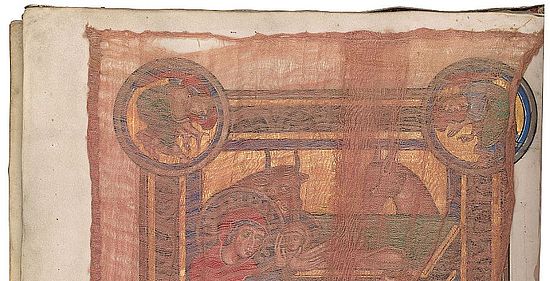
Sabrina SchmidTextures of Sacred Scripture. Materials and Semantics of Sacred Book Ornament in the Western Middle Ages, 780-1300: Textiles
In the Middle Ages, textiles were variously used to preserve manuscripts, to increase their preciousness, to protect their bindings and their images, and to enhance the devotional experience of the reader. Along with other luxury goods like gold, ivory and precious stones, textile elements were one of the most often used; at the same time, they are one of the least researched materials today. Indeed, textiles have in general long occupied a marginal position in art historical research. In addition to obstacles like their extreme fragility, such that they are usually in poor condition or not preserved at all, the phenomenon of “fast fashion” expresses a modern relationship to textiles that could hardly be in sharper contrast to that of the Middle Ages. While textiles today are mostly cheap and short-lived mass-produced goods – and thus knowledge, awareness and appreciation of their materiality is almost completely lost – in the medieval era they were manufactured in time-intensive processes and reused over centuries. Textiles embellished sacred rooms, objects, actions, or people and, in the form of clothes, hangings, tapestries and curtains, were a highly valued representational medium of social and political elites.
Although textiles (especially tapestries and liturgical vestments) have recently become a focus of research, a systematic examination of textile elements in the context of sacred scriptures in the Western Middle Ages has so textile book decoration from the 8th to the 13th century in its various material manifestations. Textiles and textile techniques were strikingly incorporated into the structure and decoration of medieval books. They served as book covers, or as parts of them together with other materials, but also as components within the book, into which they were sewn as flyleaves, pastedowns, and “curtains” (covering miniatures), or shown in painted form in so-called “textile pages”. A survey of the forms and functions of textiles in manuscripts seeks to unveil their role in the medieval reader’s experience, in the context of the importance of textiles in liturgical performance and devotional practice.
Projektwebsite: https://textures-of-scripture.com/2020/12/16/textiles/
Image Credit: Morgan Library and Museum, Dept. of Medieval and Renaissance Manuscripts, Berthold Sacramentary, The Nativity and the Annunciation to the Shepherds (detail), Weingarten, Germany, 1215–1217, MS M.710, fol. 16v, silk down. Purchased by J.P. Morgan, 1926
